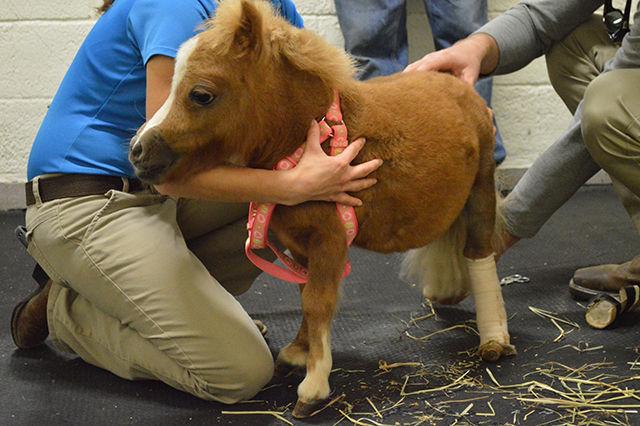Having a horse the size of a beagle is not what anyone has in mind when she thinks of taking care of a rescue animal. Tinkerbell is a 3-month-old miniature rescue horse who was born with dwarfism, and because of it, has two health problems: a loose joint that was dislocated in both of her back legs and a metatarsal bone angled off to the side.
Dwarfism is a recessive genetic trait passed on from the mother and father and could also be a host for other congenital effects. Miniature horses may grow up to about three feet tall, and Tinkerbell, due to dwarfism, might only grow to about three-quarters of that size. Tinkerbell also has a problem with her front legs from shifting her weight to the front, causing damage to her skin.
The surgery that took place for Tinkerbell’s hind legs was to connect two bones using bone plates and screws. It was performed by Benjamin Shrauner, equine surgery resident at NC State’s College of Veterinary Medicine, Denis J. Marcellin-Little, professor of orthopedic surgery and Rich Redding, equine surgical specialist. Shrauner said that if the surgery had not taken place, the joint would have become infected.
“This procedure allowed to lock the joint that was dislocating in a fixed, more normal position,” Shrauner said. “The dislocation caused her to walk on the sides of her joints instead of her feet which, if were prolonged, would be a life-threatening problem.”
Shrauner said they had screened Tinkerbell for some of the more significant potential problems that would have precluded her from the surgery, such as a heart defect. She will likely have various problems throughout her life associated with her dwarfism, but the hope is that these can be anticipated and minimized through veterinary care.
Currently, Tinkerbell is under 90 days of stall rest, meaning she will be in a stall of the barn with her mother at the College of Veterinary Medicine.
“She can’t run freely outside yet because her bones are healing,” Marcellin-Little said. “We’ll see how healing is progressing, and we’ll adjust her activity based on that assessment.”
In the meantime, there is still work to be done to make sure she can use her legs fully, such as corrective shoeing that provides support. Corrective shoeing is when a horse that doesn’t have the flat feet of normal horses gets proper care to ensure that they will, often due to irregular feet shapes.
Tinkerbell is currently being cared for by the Dunbar and Newsome families. The Dunbar family said that so far, Tinkerbell is doing very well, and they are hoping for a long and healthy life for Tinkerbell. Because she was rescued at two weeks old and required so much attention, she is more comfortable with humans than with other horses.
The families also mentioned that the only issue Tinkerbell has medically now is to try to strengthen her ligaments from the fetlock to the hoof. The Dunbar family started a GoFundMe campaign in order to pay for the surgery, as well as private donations and outsource funds.
The Dunbar family said it’s pleased Tinkerbell is recovering so well and that she will be able to run freely when her bones have healed in about three months.
Check out more photos of Tinkerbell in an online gallery at technicianonline.com/multimedia








